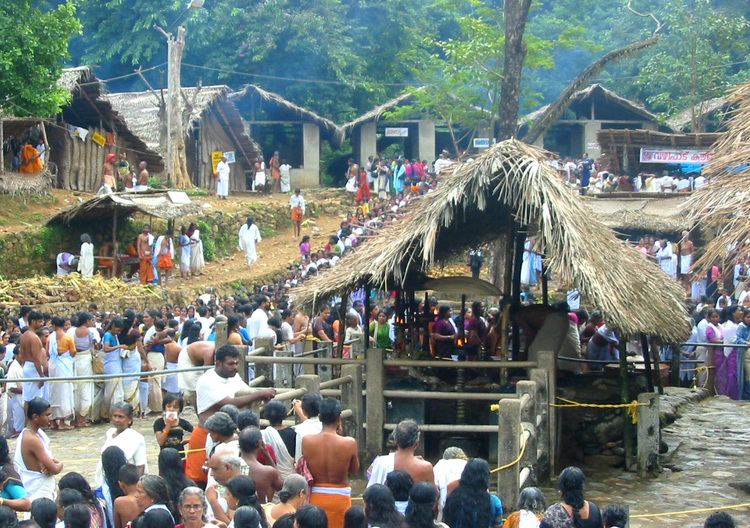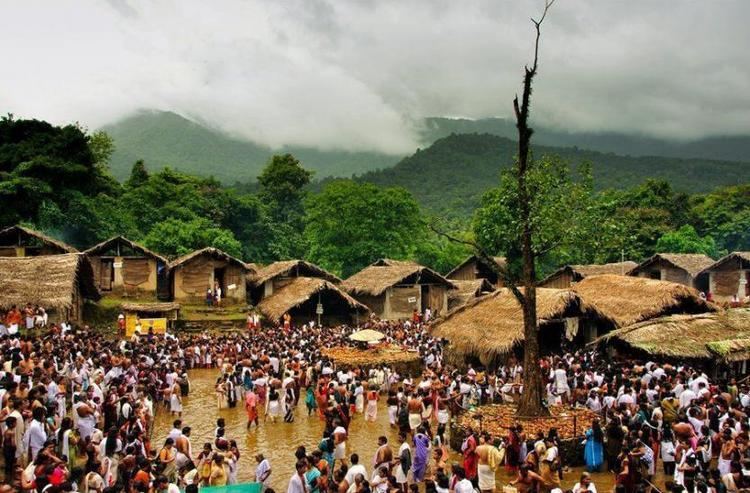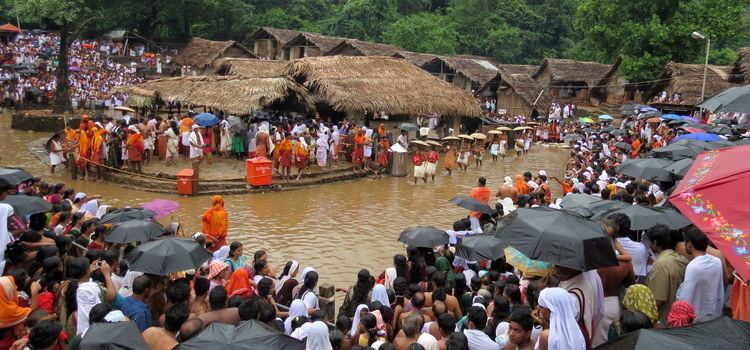Other names Ikkare Kottiyoor | Country India Important festivals Vysakha Mahotsavam | |
 | ||
Proper name Thruchherumana Temple (തൃചേരുമന ക്ഷേത്രം) Malayalam കൊട്ടിയൂർ വടക്കേശ്വരം ക്ഷേത്രം Similar Kalarivathukkal Bhagavathy Temple, Trichambaram Temple, Sree Ramaswami Temple, Muthappan Temple, Madayi Kavu | ||
Festival of akkare kottiyoor temple kannur
Kottiyoor Temple is a prominent Shiva temple in Kerala. Vadakkeshwaram Temple is the common name of the temple from ancient time, but some of the local people addresses the temple as Ikkare Kottiyoor as it in the bank of the river close to the Kottiyoor village; to differentiate it from the shrine in the other side of the river. Thruchherumana Kshetram is the proper name of Kottiyoor temple. The temple is a special category temple under Malabar Devaswom board.
Contents
- Festival of akkare kottiyoor temple kannur
- History of kottiyoor temple part 1
- Significance
- Social participation
- Thruchherumana Temple origin
- Legends
- Associations with other Temples
- Rites and Rituals schedule
- Access
- References

There are two temples in Kottiyoor - one on the western bank of the Bavali river - and the other one on the eastern bank of the Bavali river. The shrine on the east bank (Kizhakkeshwaram or Akkare Kottiyoor) is a temporary hermitage (Yaga shrine) opened only during the Vysakha festival. The Vadakkeshwaram or Ikkare Kottiyoor (The Thruchherumana Temple) on the western bank of the river is a permanent temple complex like all other temples. It remains closed throughout the year except for the 27 days of Vysakha festival. The temple is situated in a densely forested area amidst a sacred grove that covers about 80 acres. Mythology says that Akkare Kottiyoor, the shrine on the eastern bank of the river, was the location of Daksha Yaga, at the conclusion of which, Sati Devi immolated herself and thus committed suicide in this place.

The Thruchherumana Temple was built after the Swayambhoo lingam was found; however the exact date of construction of temple is not known, the pilgrimage has been taking place for many centuries.

History of kottiyoor temple part 1
Significance

The Kottiyoor Temple is highly revered in Kerala and neighboring areas of adjoining states. The legend goes that the shrine is blessed with the divine presence of The Holy Trinity or The Trimurthy (Brahma - Vishnu - Shiva) and the primodial Mother Goddess (Bhagavathy), due to this Kali (the personification of Kali Yuga), has promised Parashurama in the presence of Trimurthy in not entering the premises of the holy shrine.

Kottiyoor is one of the most sacred shrines of Shakti. There are very few shrines in India for Sati Devi amongst which Kottiyoor is one. As it is forbidden to build any permanent structures abiding by religious principles, there are only temporary and simple-looking structures, which resemblance what would look like hermits of sages. As there is no sanctum-sanatorium, Sati is worshiped as Shakti in 'Ammarakkalu Thara', a raised platform adjacent to the Swayambhoo linga where Sati Devi is believed to have committed suicide. This is believed to be the temple of the origin of the Shakti Peethas. As it is the confluence of the presence of all the known Hindu Divinities, the place is called Kottiyoor from Koodi and Uuru meaning Meeting Precinct.

The temple is well known for its old structure and is not renovated so as to not disturb the old customs and traditions of the temple.
Social participation
The Kottiyoor Pilgrimage has far reaching participation from the entire society. The Hindu communities in the region bring the raw materials as a ritual each year from even more than a hundred of kilometer away by walking. Each community have been delegated specific duty by the Kottayam (Pazhassi) royal family, and has not been re-delegated from the inception. They consider this as a right given to them and exercise their part as a duty. This has been happening as a ritual for ages and is centuries of years old tradition. The pilgrimage has become a part of their culture. The temple is located in a serene dense forest which is now declared as a Wild Life Sanctuary by Government of Kerala.
The rites and rituals of the festival is a symbol of Shaiva-Vaishnava-shakteya communal harmony. Rohini Aradhana is considered as one of the sacred ritual during the Vysakha Mahotsavam where the head of the Vaishnavite family named 'Kurumathoor', conduct 'Aalingana pushpanjali' to the Swayambhoo linga, this is to commemorate Vishnu embracing Shiva to pacify him, who was in deep sorrow when he found the burned dead body of his beloved wife Sati Devi.
Thruchherumana Temple origin
The 'Prathishta'(i.e. the installation of idol) of the Thruchherumana Temple, was done by Parashurama on the opposite river bank of the Swayambhuu linga. The Thruchherumana Temple has its objective to worship Shiva for the entire year as the Swayambhoo linga on the other bank of the river can only be worshiped during 27 days of a year. Sankaracharya had classified the rites and rituals of the temple. He came to the Thruchherumana temple and worshiped there but he did not cross the river and worshiped the Swayambhoo linga as it was not the period of Vysakha pilgrimage. This belief is strictly followed until this time, of not going to the premises of Swayambhoo linga or Akkare kottiyoor if it is not the Vysakha pilgrimage time. Sankaracharya made ablutions in the Vavali river and prayed from the west bank of the river with out crossing and continued his journey.
Legends
A pious Namboothiri of Kalakkatt Illam (one of the four major Mantravada(Sorcery) lineages of Kerala) was returning from Kottiyoor. To pray for Sandhya vandanam in Manathana Shrine he took bath in the pond, after which a young lady from the adjacent bay offered him Taali(herbal shampoo), and told that she would apply it onto his forehead. He immediately recognized that she was none other than Bhadrakali and showing his head would meand his death. He folded his hand in-front of her and said any thing given by The Mother is nectar. He took the shampoo and drank it. Devi was pleased with him and presented him with three sacred insignia which he installed in three temples in the Kannur region.
Associations with other Temples
The Puffed rice(Pori or Malaru) is prepared at "Pullancheri Illam", and handed over to the temple from Narasimhaswamy temple, Pala, near Muzhakunnu Kottiyoor Temple is also closely associated with the Tirunelli MahaVishnu Temple in Wayanad District, about 54 km from Kotttiyoor It was from Tirunelli that rice was given to Kottiyoor for Vysakha Mahotsavam and returned after the festival. This has been discontinued but rites are performed in both temples to continue the tradition. It is believed that Bhuta Ganas carry the presents of Tirunelli Perumal to Vysakha Mahotsavam. Once a Bhuta tried to steal a present and the Perumal cursed him to become a rock. The Sacred sword of Veerabhadra is brought for the Kottiyoor Festival from "Mutherikavu" a nearby temple.
Tons of fire woods are used for the Kottiyoor festival in the shrine. Not even for a single year until now has it been required to remove the excess ash from the altar. All the essentials needed for Ammarakkal Tara is brought from Manathana shrine. Sacred swords also come from Chapparam Bhagavathi temple. Pooja vessals, ornaments etc., come from Karimbanagopuram.
Rites and Rituals schedule
Present day rituals of Kottiyoor were set out by Sri Shankaracharya. With his spiritual vision, he felt the presence of Shiva at 'Akkare Kottiyoor' and not willing to pollute the holy ground with the touch of his feet, prayed from 'Ekkare Kottiyoor' and left.
The Vaisakha Maholsavam festival is held every year during the months of May - June. The twenty eight-day festival commences with the 'Neyyattam' ritual on the 'chodi' Day in Edavam (rishabham) and concludes with the Thrikkalashaattu. The Vaisakha Maholsavam celebrations begin with the ritual of bringing a sword from Muthirerikavu from Wayanad. On the following day, on Visakham star Bhandaram Ezhunnallath ritual is held. Gold, Silver vessels, and heavenly ornaments of precious metals and precious stones are brought from the nearby Manathana village to Kottiyoor.
An important ritual during the festival is the 'Elaneer Vayppu' or submitting tender coconuts before the swayambhu Shiva linga. On this special day, thousands of tender coconuts carried from different parts of Malabar by the devotees are submitted. The following day, the main priest of the temple, pours the collected coconut water on to the idol which is known as 'Elaneeraattam'. Rohini Aaradhana is a very important ritual which is not seen in any other temple. Kurumathur Brahman (The senior most member of Kurumathur family considered as the embodiment of Vishnu in the ritual) embraces the swayambhu Shiva linga as part of the ritual. The belief is Vishnu pacifying Shiva who is saddened by the loss of Sati.
As a part of the festival, a procession (Ezhunnallippu) is held with two elephants carrying the idols of Shiva and Parvathi. After the procession, the elephants are fed well (Aanayootu) and given a formal farewell.
The Thammangadan Nambiar Family (The Vediyara Chandrothu Tharavadu), a sub-branch of the Mushika (anciently known as 'Nannan' and later as the Kolathiri Royal Family), use to have by tradition, the right to being the first to have their Ghee offered to the Deity for 'Abhishekam', during the "Naallam Thurakkal" ritual, at the Kottiyur Shiva Temple, believed to be the site for the famous Yajna of Daksha. Now a days this right is being performed by the Villippalan Kurup of Kadathanadu.
Access
The national highway passes through Kannur town. Mangalore and Mumbai can be accessed on the northern side and Cochin and Thiruvananthapuram can be accessed on the southern side. The road to the east of Iritty connects to Mysore and Bangalore. The nearest railway station is Kannur on Mangalore-Palakkad line. There are airports at Mangalore and Calicut.
